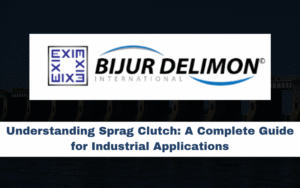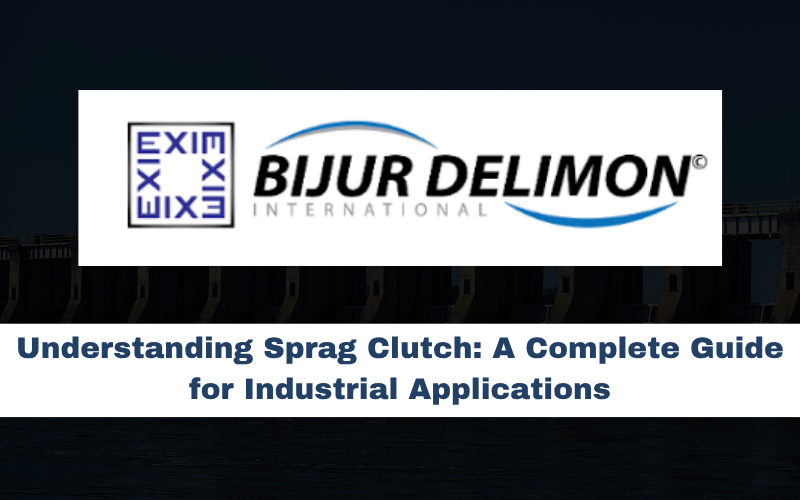In the world of industrial machinery and power transmission, one component that quietly ensures smooth operation, safety, and efficiency is the sprag clutch. Though often overlooked, its importance in one-way rotation and backstopping mechanisms across various applications—such as conveyors, automotive transmissions, and aerospace equipment—is undeniable.
In this blog, we’ll break down everything you need to know about sprag clutches—from how they work to their applications, benefits, and key considerations when selecting one for your machinery. Whether you’re an engineer, buyer, or maintenance professional, understanding the sprag clutch mechanism can give you a major edge in optimizing system performance.
What Is a Sprag Clutch?
A sprag clutch is a type of one-way clutch or overrunning clutch that transmits torque in one direction while allowing free rotation in the opposite direction. It consists of precision-engineered elements called “sprags” placed between inner and outer races. These sprags tilt or lock depending on the direction of rotation, engaging the shaft when needed and overrunning it when not.
Unlike roller clutches, sprag clutches do not rely on external control mechanisms—they automatically engage or disengage based on load direction and torque.
How Does a Sprag Clutch Work?
The core operating principle of a sprag clutch lies in the camming action of the sprags. Here’s how it functions:
- Engagement: When torque is applied in the driving direction, the sprags tilt and wedge between the inner and outer raceways. This creates a frictional lock that transfers torque.
- Overrunning: When the rotation direction is reversed or the driven shaft moves faster than the driver, the sprags disengage, allowing free rotation without any torque transmission.
- Backstopping: In some systems, the clutch prevents reverse rotation entirely—essential in conveyor systems or hoists to avoid back-driving.
This mechanism ensures low-noise operation, instant torque transmission, and automatic engagement, making it ideal for high-performance systems.
Key Advantages of Sprag Clutches
Integrating a sprag clutch into your industrial system offers several benefits:
- Automatic One-Way Engagement: No need for external controls.
- Compact Design: Ideal for space-constrained setups.
- High Torque Capacity: Efficiently handles dynamic loads.
- Low Maintenance: Few moving parts mean reduced wear and tear.
- Rapid Response: Instantaneous torque transmission improves operational reliability.
- Energy Efficiency: Prevents unnecessary energy loss during overrunning phases.
These advantages make sprag clutches indispensable in sectors like mining, automotive, packaging, aerospace, and material handling.
Common Applications of Sprag Clutch
Sprag clutches are found in a wide range of industries. Let’s explore some typical uses:
1. Automotive Transmissions
In automatic transmissions, sprag clutches enable gear changes by engaging and disengaging without manual control. They provide seamless torque flow during upshifts and downshifts, improving driving comfort and fuel efficiency.
2. Backstopping in Conveyors
In heavy-duty conveyor systems, sprag clutches act as backstops, preventing reverse movement in case of motor failure or load rollback. This is especially vital in mining and quarrying applications.
3. Helicopter Rotors (Aerospace)
Sprag clutches ensure that the main rotor of a helicopter can continue rotating during engine failure, allowing for safe autorotation and emergency landings.
4. Generators and Pumps
Sprag clutches are used in overrunning alternators, helping reduce belt tension and engine load. Similarly, in pumps, they prevent reverse fluid flow or shaft rotation.
5. Start-Up Drives
They help disengage the drive once the system reaches a set speed, allowing a secondary power source to take over. This application is common in dual-motor or dual-speed systems.
Types of Sprag Clutches
When selecting a sprag clutch, it’s essential to understand the different configurations available:
1. Bearing Supported Sprag Clutch
This clutch comes with internal support bearings and is ready for installation. It’s widely used for backstopping and indexing applications.
2. Shaft-Mounted Sprag Clutch
This type mounts directly onto a shaft and requires external bearing support. It’s compact and suitable for OEM machinery.
3. Cage-Type Sprag Clutch
The sprags are enclosed in a cage assembly and inserted between two races. These are ideal for high-speed, precision applications.
4. Integrated Backstop Clutch
Built directly into conveyor drives or gearboxes, these clutches offer enhanced safety and minimal footprint.
How to Choose the Right Sprag Clutch
Choosing the right sprag clutch requires understanding your application’s operational needs and limitations. Consider the following factors:
- Torque Requirements: Determine both peak and continuous torque values.
- Speed Range: Make sure the clutch can handle your operational RPMs.
- Mounting Orientation: Decide between shaft-mounted or housing-mounted types.
- Duty Cycle: Assess whether it will be used for continuous, intermittent, or emergency use.
- Environment: Evaluate temperature, dust, vibration, and lubrication needs.
- Life Expectancy: Based on your industry, choose a clutch rated for long service life with minimal downtime.
Maintenance Tips for Sprag Clutches
Though sprag clutches are relatively low-maintenance, proper care can significantly extend their lifespan:
- Use clean lubricants: Dirty or incompatible lubricants can damage the sprags.
- Regular inspections: Check for noise, overheating, or unexpected engagement issues.
- Proper alignment: Ensure the clutch and shaft are aligned to avoid premature wear.
- Avoid shock loads: Use torque limiters or dampers to prevent sprag deformation.
By following these guidelines, you can keep your sprag clutch in peak operating condition for years.
Sprag Clutch vs. Roller Clutch: What’s the Difference?
While both clutches allow one-way rotation, they differ in design and performance.
| Feature | Sprag Clutch | Roller Clutch |
|---|---|---|
| Engagement Mechanism | Camming sprags | Rolling elements |
| Torque Capacity | Higher | Lower |
| Size | More compact | Slightly bulkier |
| Wear Resistance | Superior | Moderate |
| Cost | Slightly higher | Economical |
If your application demands high torque and compact design, a sprag clutch is usually the better choice.
Why Sprag Clutches Are Ideal for High-Performance Industries
Industries such as automotive, aerospace, and mining require components that are not only efficient but also fail-safe. Sprag clutches provide this by allowing controlled overrunning and backstopping without external intervention. Their ability to work silently and reliably, even in harsh conditions, makes them a preferred solution among engineers.
For example, in conveyor systems, a sprag clutch prevents the belt from reversing when the power fails—protecting both equipment and personnel. In helicopters, it can mean the difference between a safe landing and a catastrophic failure.
Conclusion: Invest in the Right Sprag Clutch for Maximum Efficiency
A sprag clutch may be a small component, but it plays a critical role in ensuring operational continuity, safety, and efficiency across multiple industries. Whether you need a backstop for a mining conveyor, an overrunning clutch for an alternator, or a failsafe device for aerospace systems, sprag clutches deliver reliable performance with minimal maintenance.
If you’re sourcing high-quality sprag clutches, always partner with trusted suppliers who offer engineering support, warranty-backed products, and custom solutions to meet your application’s unique requirements.
Contact us for more info – Bijurexim.com
FAQ’S
Q1: Can a sprag clutch be repaired or should it be replaced?
Most industrial-grade sprag clutches are designed for longevity, but if worn or damaged, they are best replaced rather than repaired to ensure safety and performance.
Q2: Are sprag clutches noisy during operation?
No. They are designed for quiet, seamless operation, especially during overrunning phases.
Q3: What lubrication is recommended for sprag clutches?
Use manufacturer-recommended oils or greases, typically synthetic, that prevent slippage and overheating.
Q4: Can I use a sprag clutch in both directions?
No. Sprag clutches are uni-directional by design and engage torque only in one direction.
MORE QUERIES
- Rigid Coupling: Everything You Need to Know
 Rigid Coupling – When it comes to connecting two shafts to transmit torque and motion without any
Rigid Coupling – When it comes to connecting two shafts to transmit torque and motion without any - Pulley with Belt: A Complete Guide for Industrial Applications
 Pulley with Belt – In today’s fast-paced industrial world, mechanical power transmission is at the heart of
Pulley with Belt – In today’s fast-paced industrial world, mechanical power transmission is at the heart of - Understanding Sprag Clutch: A Complete Guide for Industrial Applications
 In the world of industrial machinery and power transmission, one component that quietly ensures smooth operation, safety,
In the world of industrial machinery and power transmission, one component that quietly ensures smooth operation, safety, - V-Belt Size Chart: Everything You Need to Know for Accurate Belt Selection
 V-belts are one of the most commonly used power transmission components in machinery. Whether you’re working with
V-belts are one of the most commonly used power transmission components in machinery. Whether you’re working with - Understanding the Role of Pump-Reservoir Systems in Industrial Applications
 In industrial automation and manufacturing, fluid handling systems are critical for performance and longevity. One such essential
In industrial automation and manufacturing, fluid handling systems are critical for performance and longevity. One such essential - Understanding Kinematic Viscosity: Definition, Importance, and Industrial Applications
 When dealing with lubricants, hydraulic fluids, or industrial machinery, one of the most important parameters engineers and
When dealing with lubricants, hydraulic fluids, or industrial machinery, one of the most important parameters engineers and

